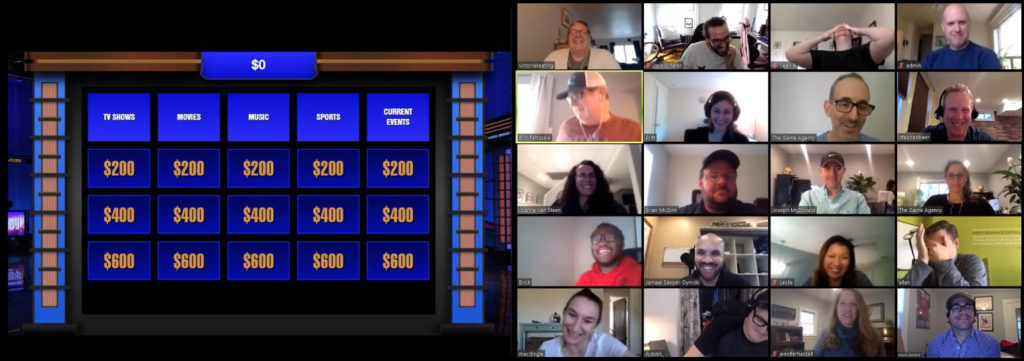On March 9th, we hosted a webinar with ELB Learning titled: 10 Ways to Make your Virtual Meetings more Grand Slam and Less Slow Jam. This webinar provides helpful tips on how to make your virtual meetings more interactive.
Mark Gindick, a former lead clown with Cirque du Soleil, Ringling Brothers, and the Big Apple Circus, hosted the webinar along with Chief Creative Officer, Stephen Baer. Mark has first-hand experience on how to make his audience laugh and how to keep their attention. That can be even more challenging today with so many meetings occurring on Zoom or other web conferencing tools. Mark shares his 10 actionable tips to help you keep your audience engaged and actively participating.
Mark and Stephen tried to stay away from the typical advice for how to make a virtual meeting more fun and instead focused on what really works on stage and how you can apply it in your virtual classroom or virtual meeting.
Here are the top 10 tips and tricks that will set your meetings apart from all the others.
1. Have Fun
It may seem simple, but it can be easy to forget when you spend so much time and money planning an event. When Mark built his one-man show called Wing-Man, one of my mentors said, “Hey, Mark, are you having any fun? Because, once the show starts, it’s just time to have fun. And, if you’re having fun, then your audience is having fun.”
One of his favorite clowns, Rob Torres, had an awesome act where he taught his audience that every time they clapped, he would take their applause and put it into a little music box. And every time he would open the box, the audience would clap. What he was really doing was teaching the audience to have a good time. As soon as they started clapping, they would think “I must be having a good time. Oh, I am having a good time.” It’s all about the relationship and the dialog that you’re going to have with the audience. Encourage them to have a good time.
2. Make a Theme
In the theater world, and anywhere that requires storytelling, it’s all about the theme. The theme is essentially the content you’re going to hang everything on; it’s what your audience is grabbing on to. There are lots of ways to do this, even in the virtual world. One of our most successful games at The Training Arcade® is an 80’s themed JEOPARDY!® game. Some of our clients will host an 80s themed virtual JEOPARDY! game and everyone will dress from the 80s, have their backgrounds set as the 80s, and play 80s music. So fun, right? These are very simple things that you can do with your audience. Once you add to the theme, there are connections and everyone loves the nostalgia.
It’s important to think about characters, too. As you tell a story, give your corporate learners a role and have them play through different scenarios. You can do this in a virtual class and a virtual meeting. Either way, pick something that will resonate with your audience. Make sure they’re not only a part of defining this in advance of your training, but are a part of it throughout, too.
3. Play with Purpose
This is the foundation of what The Game Agency is all about. Play with Purpose is utilizing gameplay to educate, activate, and motivate people. The more that you can use games to do that, the better. Our JEOPARDY! online game is a multiplayer game that can be played on Zoom or any other web conferencing software. It brings all the sights and sounds of America’s Favorite Quiz Show® to life with rounds for JEOPARDY!, Double JEOPARDY!, and Final JEOPARDY! plus “Daily Doubles”. Up to 500 people can play simultaneously, live for fun or for prizes.
Escape Rooms – now, there’s even a virtual way of doing this. Escape rooms facilitate collaboration and teamwork; participants are more successful when they work together.
Scavenger hunts – a more competitive game. You can do this virtually by coming up with a list of items and having participants try to be the first to find and bring the item to their screens.
Mad Libs – talk about nostalgia, right? Ask participants to give you nouns, verbs, adjectives, and adverbs, and then read them the hilarious story they’ve created.
The point is to hopefully bring a smile to people’s faces and allow them to take a break, engage, and participate in a meaningful way.
4. Silence is OK
When Mark was in his thirties, he had a gigantic booking with roughly 2,500 seats every night. When the lights would come on after intermission, he would look and see some empty seats. He would think, “They must hate me. Why didn’t that person come back?” But he was forgetting about the other two thousand people that are having an amazing time.
Forget about the empty seat, because it doesn’t mean anything. Maybe that person went to the bathroom, or they’re having a bad day and had to run home to take care of something. It could possibly mean they aren’t having a good time, but the other two thousand people are so it’s OK.
Johnny Depp was on Actor’s Studio and he said to an interviewer, “This can be the most beautiful, delicious, juicy peach in the world. But some people don’t like peaches.” You cannot please everybody. If we focus on the people who are truly engaged and create an inclusive experience, we may be able to bring those silent people out of their shells and get them talking.
5. Go Fishing
Find the right people to include. Audience participation is not just about one person participating, it’s the entire audience. It’s like a fisherman who puts out as many leads as possible and to see who bites. Here’s a technique that he uses: when there’s an audience of two thousand people, he looks one person in the eyes, maybe two or three rows back, and when he makes that real connection with them, the surrounding people feel like he is also looking at them. How do you do this virtually? Sometimes all you have to do is say their name. Or, if you know that your audience members want to remain anonymous, you can simply read their comments from the chat box, without saying who said it. It’s that simple.
6. Play the Room
Mark would say this phrase to his comedy partner every single time before we would go on stage, before we played a cruise ship, before we did a circus. Each setting has different people, so you’re going to say different things. You’re not going to have the same tone in a library as you would have in a giant arena or in a virtual setting. These are different venues, and there are lots of different rules.
The fundamentals are the same: Be honest and upfront about what you want at the beginning of the meeting. Here’s an example: “Hey guys, welcome to the meeting. You know what’s going to make this meeting really fun? Turning on your cameras. That way we can see each other and have a good time together.”
If a rockstar goes to play an electric guitar in the library, the audience is going to say “turn it down.” If the rockstar was actually playing the room, he would play a small acoustic set, with just an acoustic guitar. Don’t forget the setting that you’re playing in.
7. Spin the Wheel
Stephen has lots of props for everything that he does. They’re a great little way to keep people on their toes. He bought this wheel at IKEA for 25 bucks, and then he throws people’s names on each color or he’ll put different choices on it. It keeps things suspenseful and makes a game out of it; the more you can do that, the better.
There’s a bubbly feeling you get when you wonder – Is my name going to be called? What’s going to be selected? It’s that element of chance. The suspensefulness keeps it spontaneous and exciting.
8. Prizes
You want to take into account someone’s intrinsic and extrinsic motivations, and prizes fall into the extrinsic category. Everyone likes prizes, and they come in all shapes and sizes. For example, you can do:
Gift cards: They’re really simple and the amount doesn’t matter. People are just excited to win.
Tangible goods: Big prizes like iPads or Apple Watches.
Experiences: How about winning an experience with the CEO? You can have coffee, you can have dinner, you can just hang. It is an incredible opportunity to be with someone you look up to, and to just have a few minutes with them in an unconventional non-work environment where you can learn from and interact with that person.
9. Embrace the Butterflies
The butterflies are to be embraced, not to be chased away. They’re what’s going to get you the energy, and the last push to do something awesome. We want to do something awesome, not just OK. And if you’re not getting butterflies, you run the risk of just being OK.
Give it all you got. It might suck and it might be really horrible, but the butterflies show that you care. Mark says “I feel nervous when I’m NOT nervous. And then I get nervous, and then I hopefully do a great job.”
10. Be Yourself
At the end of the day, people want to make a connection with who you are, and hopefully they’re there to learn from you or learn with you. It’s not about putting on a show or some facade. They’re letting you into their bedrooms or office or wherever they’re dialing in from. Let them into who you are, too. They want to know about you and to have a good time with you. Be vulnerable, be open, be willing to make a giant fool of yourself. But, only if that’s who you are. The reality is not everyone can be an entertainer, right? But they need to be true to who they are. Not everyone needs to be the life of the party to be a great facilitator.
Come with a personal voice, come with your personality, come who you are. Turn that dial up just a little bit so you can play the room, and go for it.
Three Key Takeaways:
- K.I.S.S. – Keep It Super Simple: We just gave you 10 ways that you can enhance your presentations. Pick the one or two that work best for you. If you took all of those things, it would be too much – it would be like telling one or two jokes on top of each other. Pick a couple and start working out your own kind of voice. This takes practice, failing, and doing it again. And that’s OK.
- Keep it a conversation: People will retain the information better when they take part in the conversation. Include them, even if it’s just through the virtual chatbox.
- Keep it fun: This is everything – if you’re having fun, they’re having fun.





